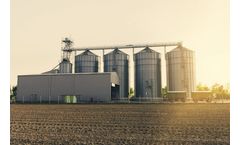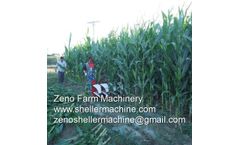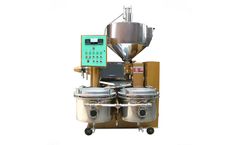Grain Farming Articles & Analysis
21 articles found
Most of us have heard of “Internet of Things (IoT)” – the interconnected cloud and devices, like our smart watches, that we use everyday to make lives easier. But what do these smart solutions or the cloud have to do with farming? Everything, according to Jeffrey Poppel, senior product manager for Decisive Farming by TELUS Agriculture. ...
W hen a fire destroyed an old 800-bph grain dryer at LaBolt Farmers Grain Co. in South Shore, SD (605-756-4220), in early 2020, , the cooperative had the chance not only to replace it but boost drying capacity, as well, at the branch elevator in far eastern South ...
From Leasing to Wind Farms to Owning His Own. Cosmos, Minnesota (USA), sits along the South Fork of the Crow River. Grain is the lifeblood of the small city, having been founded in 1867 by a pair of wheat farmers. ...
ByEocycle
Meeting the food requirements of a growing global population is becoming increasingly difficult. Despite the need for additional food, it is estimated that 50-60% of grain is lost after harvesting, at a cost of about $1 trillion per year.1 One of the major reasons for lost grain is spoilage due to mould or insect infestation during storage.2 To provide a constant supply of grain year-round, after ...
There are several example of commercial farming types Dairy Farming Commercial grain farming Plantation Farming Livestock Ranching Mediterranean Agriculture Mixed Crop and Livestock Farming Commercial Gardening and Fruit Farming Difference Between Subsistence ...
During the busy harvest season, the last thing you need is errors caused by miscommunication—especially when they involve the grain cart. Unfortunately, all too often, farmers encounter: Difficulty finding qualified grain cart drivers Problems communicating with the grain cart operator Grain cart drivers not ...
And the continued wet weather means that now high and variable grain moisture levels are presenting problems with grain handling and storing. ...
YZYX70ZWY is a integrated oil press combined the function of roaster(heating the raw materials), the oil pressing and the oil filtering. It has advantages of easy operation and high oil yield. Main equipment parameters of YZYX70ZWY Integrated Oil Press Model YZYX70ZWY Capacity(t/24h) 0.8 Residual Oil in cake(%) ≤7.8 Power Of Pressing(kw) 4 Power Of Frying(kw) 6 Power Of Filtration(kw) 0.75 ...
During the busy harvest season, the last thing you want to see is a combine sitting with a full grain tank because of mistakes made by the grain cart operator. Unfortunately, all too often, farmers encounter: Difficulty finding qualified grain cart operators Problems communicating with the grain cart operator ...
We don’t have that luxury when it comes to solving agricultural problems. Zoom out from Memphis to farms nearby in the Mississippi Delta, and then try searching for “cotton field” within Google Maps – you will be waiting a while! The fields, farms, and grain bins that power one of the most fertile farming ...
Here’s just a little taste of what we do: Vertical farming – the mission of vertical farming is to create food products in an efficient and waste-free way. ...
The automotive industry boomed in the United States during the mid-twentieth century. This paired with the development of an interstate highway system led to a new method for the transport of agricultural products: trucking. Hauling grain by truck became a potentially cheaper and more efficient alternative to trains and steamships, depending on the distances involved. Access was the critical ...
Farmers are now able to test the quality of their grain, and then store it on-farm to preserve its identity. Increasingly efficient trucks with advanced routing capabilities can bring identity-preserved, high quality grain from farmer to buyer. ...
Grain handling, storage and drying equipment is needed on many farms, large agriculture operations and some commercial businesses. ...
Meeting the food requirements of a growing global population is becoming increasingly difficult. Despite the need for additional food, it is estimated that 50-60% of grain is lost after harvesting, at a cost of about $1 trillion per year.1 One of the major reasons for lost grain is spoilage due to mould or insect infestation during storage.2 To provide a constant supply of grain year-round, ...
In the agricultural sector, scales are indispensable tools and without them, it would be almost impossible to manage farms or carry out trade! How Have Modern-Day Farm Scales Changed the Industry? ...
In the late 1900s, as per-acre grain yields moved to 3 metric tons per hectare in South and Southeast Asia and Latin America, 5 metric tons per hectare in China, and 10 metric tons per hectare in North America, Europe and Japan, there’s one place where production stagnated big time: sub-Saharan Africa, where loss of soil fertility on small farms trapped ...
ByEnsia
By Lester R. Brown Overnight, China has become a leading world grain importer, set to buy a staggering 22 million tons in the 2013–14 trade year, according to the latest U.S. Department of Agriculture projections. As recently as 2006—just eight years ago—China had a grain surplus and was exporting 10 million tons. What caused this dramatic shift? It wasn’t until 20 years ...
The Grange also influenced the passage of the Federal Farm Loan Act of 1916 and the development of the farm credit system. ...
Better grain storage would save money and feed over a billion, says Digvir S. Jayas. It deserves more attention. Annually over 2.6 billion tonnes of grains — cereals, oilseeds and pulses — are grown and then stored along the chain from producers to consumers. Most countries do not systematically report how much grain becomes unfit for human consumption during storage, but anecdotal ...
















